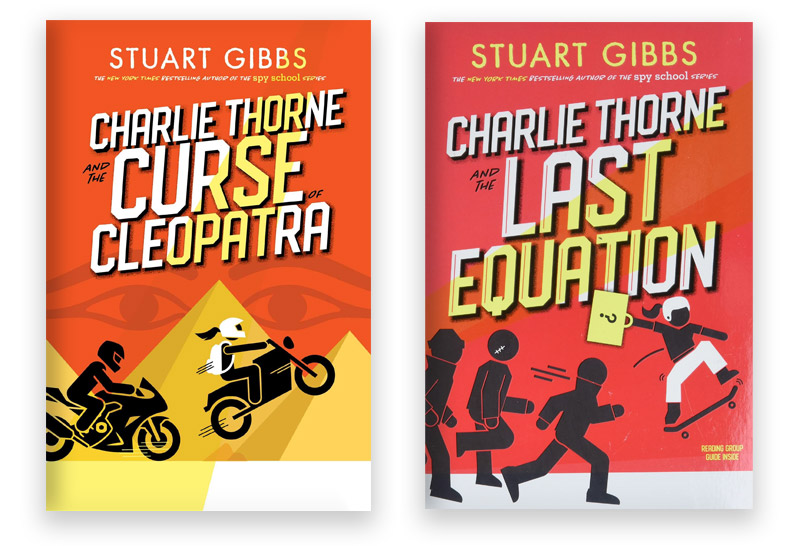Teacher Pamela Kramer does a great job of summing up a few of the factors that have turned Stuart Gibbs into a New York Times bestselling author for middle grade readers. In her blog review of Charlie Thorne and the Lost City (Simon & Schuster, 2021), Kramer says, “This is exactly the kind of book that teachers love to recommend because kids will definitely enjoy it. And getting kids excited about reading is sometimes just a matter of finding them an author they love. I can attest that my students adore Stuart Gibbs’ books.” Fortunately for those students, in 2022, Gibbs not only added another Charlie Thorne book and expanded his Spy School series, but he also launched his first illustrated series with Once Upon a Tim (Simon & Schuster, 2022). The new series showcases the author’s characteristic humor and action, this time by turning fairy-tale clichés on their heads.

Here, Gibbs talks with Lisa Bullard about his move into illustrated and graphic books, how his own kids have influenced his titles, and what students need to understand about revising their own writing.
Your recent books not only continue to feature your signature fast-paced storytelling, but some of them also feature a fresh direction for you—strong visual components. How did these titles come about?
It has been a great joy to do these new books and get to collaborate with two exceptionally talented artists: Anjan Sarkar for Spy School the Graphic Novel (Simon & Schuster, 2022) and Stacy Curtis for Once Upon a Tim. Lucy Cummins, my wonderful art director (and cover designer) at Simon & Schuster, was crucial in finding both of them and has been a major part of this process.
My publisher and I got the idea to do the graphic novel at about the same time. We both perceived that graphic novels were really taking off in popularity and thought it would be exciting to do one. Figuring out how to retell the original story from Spy School was an intriguing challenge. I used to be a screenwriter (and still occasionally work as one), so to create the script for the graphic novel I just wrote a scripted version of the book. I had to slim down the original story a bit, and to take advantage of the visual medium, I added an action sequence at the beginning that doesn’t exist in the book. Then, Anjan turned it all into a wonderful graphic novel.
One Upon a Tim came out of discussions with my publisher, Justin Chanda. It was Justin’s suggestion that I do an illustrated series, and I jumped at the chance. I’d had the idea for Tim at least a decade earlier but hadn’t known what to do with it, and it seemed perfect for this format. This type of story has its challenges: figuring out the right mix of text and illustrations to tell the story can be tricky, and doing the layout can be difficult for the designers. But I have been very lucky to have a great team, and it has been so much fun to work with Stacy.
The best part of this process is getting to see the art that Stacy and Anjan have designed. Seeing my ideas brought to life—often in an extremely hilarious way—is always a great experience.

Book series are a big hit with young readers. They love to reengage with a familiar world and characters. What do you most enjoy about writing books in series?
The best thing about doing a series is certainly getting to keep working with the same characters. I presume that’s why every author does a series: We love the characters we have created and don’t want to say goodbye to them.
I presume that’s why every author does a series: We love the characters we have created and don’t want to say goodbye to them.”
How do you achieve a balance between allowing your characters to evolve over the course of a series—but not letting them outgrow their middle grade audience?
I think it’s extremely important to have my characters grow over the course of a series—but they don’t have to grow that fast. I really try to let them subtly mature and change as the series goes on. For example, in the Spy School series, Ben is slowly becoming a better and better spy, while Erica is becoming a better and better person.
Humor is a hallmark of your writing, and that’s another thing that makes your books such a big hit with young readers. What tactics do you use to “find the funny”?
Humor comes rather naturally to me, but in a sense, I have also been studying comedy my whole life. I love jokes and funny movies, and when I was a kid, while other friends were listening to music, I was listening to comedians. There are different ways to make something funny: It could be the voice of your lead character, or building up to a big, chaotic comedy sequence, or slipping in a pun here and there. One of the most fun things about the Once Upon a Tim series is that it is completely unbound by any kind of reality. So really, I can throw in almost any joke that occurs to me, no matter how ridiculous. That is the main reason that I have enjoyed writing this series.
I love jokes and funny movies, and when I was a kid, while other friends were listening to music, I was listening to comedians.”

While reading some of your newest titles, I found myself appreciating your “scholarly sneakiness.” For example, in Charlie Thorne and the Curse of Cleopatra (Simon & Schuster, 2022), you weave all sorts of historical and geographical tidbits into the story. And you slip a lot of reader-friendly vocabulary lessons into Once Upon a Tim. What inspired those additions?
When I was in middle school, I discovered the books of Michael Crichton and was absolutely blown away. I read Congo first, then devoured everything else he had written. I loved how he combined adventure and science. Not only were the books page-turners, but I also learned so much reading them. That really resonated with me, so I figured that if I had appreciated that, then maybe other young readers would too. Part of what drew me to creating the Charlie Thorne series was a chance to weave history and science into a book. With the vocabulary in Once Upon a Tim, I simply wanted to use words that I thought were wonderful (and sometimes amusing) even though my readers might not know them. So, I hit upon the idea of adding IQ Boosters to the book, which don’t just educate, but also allow kids to tell their parents (or teachers) that they’re learning while reading my books.
As you say, your Charlie Thorne titles are packed full of facts, and your character also travels to some amazing corners of the world. Do the facts usually inspire your fiction—or does the made-up stuff come first for you?
The facts really inspire the fiction. I try to be as factual as possible in that series—although I obviously have to bend reality a bit. I start by coming up with an iconic historical figure and then doing a lot of research. I read biographies, science, history, and much more and slowly begin to sketch out the ideas for the book. If I can send Charlie to a place that I have visited before, that’s a plus, but a lot of the inspiration for these books has come from traveling to places where I wanted to set the story. There’s really no better way to get inspired than to visit the actual locations I want my story to take place.

In what ways have your own children helped shape your books?
When my kids were younger, I often built stories (or subplots) around things they were fascinated by, because I figured that if they were fascinated by something, then other kids might be fascinated by it too. So, there are storylines in the FunJungle series about sharks and rhinos and dolphins because of them. When they got older, they came with me on research trips, whether it was something local, like a visit to talk with a fossil curator at the natural history museum; or far-flung, like a vacation to another country. I like to tell them what I’m thinking about, and often, we can brainstorm ideas together. And if they suddenly turn to me and say, “This is a great place for an action sequence,” then I know I should set an action sequence there. So, there are definitely many things they have inspired in my books.

When my kids were younger, I often built stories (or subplots) around things they were fascinated by, because I figured that if they were fascinated by something, then other kids might be fascinated by it too.”
What would you like to share with fans about your upcoming titles?
Oh, I have a lot of exciting things planned for the future. There’s going to be some good twists in upcoming Spy School books; lots of fun adventures (with many, many jokes) in the Tim series; and a new FunJungle mystery involving a dead whale next spring. I’m also hard at work creating the story for the fourth Charlie Thorne book. All these stories are going to take my characters (and thus, my readers) to a whole lot of new and intriguing places.
Do you have any tips to offer young writers?
I am a huge believer in outlining before you write. I know that there are authors who don’t do this, but I find it ultimately saves time, prevents writer’s block, and protects you from getting halfway into a book and discovering that you don’t know how to end it.
I also think it’s important for kids to recognize that you are going to do multiple drafts of something to make it good. No writer nails everything on their first draft. But I often hear from young writers who are very frustrated that what they have written in their first draft isn’t good enough. That’s fine! Don’t get hung up on your first draft. Not every line needs to be perfect. The important thing is to just write something. You’ll make it better in the next draft.
I also think it’s important for kids to recognize that you are going to do multiple drafts of something to make it good. No writer nails everything on their first draft.”
What are the best ways for readers to connect with you or to follow you on social media?
I have a lot of information about my upcoming books and events on my website www.stuartgibbs.com as well as a FAQ page and a blog, so if anyone has a question, there’s a very good chance they can find the answer there. If someone still can’t find the answer to their question after all that, the best way to connect with me is through the email address at the bottom of the FAQ page. I’m also @AuthorStuGibbs on Twitter and stuartgibbs1 on Instagram. I post my travel photos on Instagram, but I should point out that Instagram is a terrible way to contact me; visit my website and email me instead.






